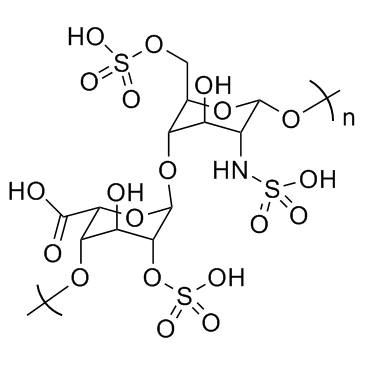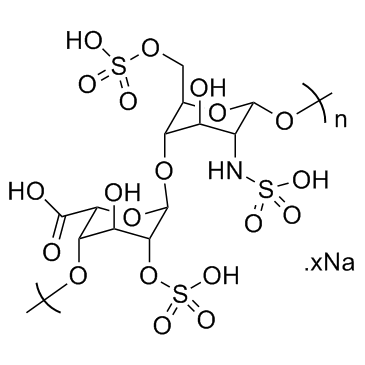9005-49-6
| Name | Heparin |
|---|---|
| Synonyms |
clarin
thrombophob HED heparin liquaemin Enoxaparine pularin Depo heparin MFCD00081689 EINECS 232-681-7 |
| Description | Heparin is a highly sulfated glycosaminoglycan,that is widely used as an injectable anticoagulant, and has the highest negative charge density of any known biological molecule. |
|---|---|
| Related Catalog | |
| Target |
Human Endogenous Metabolite |
| In Vitro | Heparin is a potent anticoagulant drug based on its ability to accelerate the rate at which antithrombin inhibits serine proteases in the blood coagulation cascade. Heparin and the structurally related heparan sulfate are complex linear polymers comprised of a mixture of chains of different length, having variable sequences. Heparin interactes most tightly with peptides containing a complementary binding site of high positive charge density. Heparin and heparan sulfate predominantly exhibit linear helical secondary structures with sulfo and carboxyl groups displayed at defined intervals and in defined orientations along the polysaccharide backbone. Heparin resembles DNA as both are highly charged linear polymers that behave as polyelectrolytes. Heparin is believed to function as an anticoagulant primarily through its interaction with AT III by enhancing AT-III-mediated inhibition of blood coagulation factors, including thrombin and factor Xa. Heparin binds to AT III and thrombin in a ternary complex, increasing the bimolecular rate constant for the inhibition of thrombin by a factor of 2000. Heparin is principally located in the granules of tissue mast cells that are closely associated with the immune response. Heparin makes numerous contacts with both FGF-2 and FGFR-1 stabilizing FGF–FGFR binding. Heparin also makes contacts with the FGFR-1 of the adjacent FGF–FGFR complex, thus seeming to promote FGFR dimerization[1]. |
| References |
[1]. Capila I, et al. Heparin-protein interactions. Angew Chem Int Ed Engl. 2002 Feb 1;41(3):391-412. |
| Density | 2.18 g/cm3 |
|---|---|
| Boiling Point | 644.9ºC at 760mmHg |
| Molecular Formula | C26H42N2O37S5 |
| Molecular Weight | 1134.93000 |
| Flash Point | 343.8ºC |
| Exact Mass | 1134.01000 |
| PSA | 652.39000 |
| Index of Refraction | 1.711 |
| Water Solubility | H2O: 50 mg/mL, clear, faintly yellow |
CHEMICAL IDENTIFICATION
HEALTH HAZARD DATAACUTE TOXICITY DATA
MUTATION DATA
|
| Safety Phrases | 24/25 |
|---|---|
| WGK Germany | 2 |
| RTECS | MI0850000 |
| HS Code | 3001901000 |
|
~% 
9005-49-6 |
| Literature: Carbohydrate Research, , vol. 340, # 6 p. 1185 - 1191 |
| HS Code | 3001901000 |
|---|
